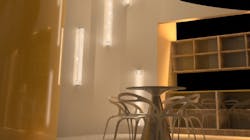Consider Specifying Color and Light at the Same Time
Interior designers have been frequently asked the questions: “Would you recommend paint colors for my house?” or “Which color do you suggest painting my office?” Honestly, it is challenging to select colors without reason. So I usually answer back with, “Which color do you prefer for your living room and why?”
It’s easy for people to think that selecting colors is based merely on personal preference or well-balanced color combinations. However, deciding color schemes for interior environments is more than that. Color is a significant factor that affects emotional and psychological reactions in humans. Additionally, colors are applied to an indoor environment, which is a 3D space where people live, rest and work for most of their time.
Color’s Psychological Effects
Psychological effects of color, (e.g. impressions or associations) have been investigated for the study of human social needs and responses to color. For instance, red has a positive association with passion, strength and warmth; in contrast, blue has a positive impression of calmness, security and comfort.
These effects help represent designers’ intentions as well as create healthy and safe environments for humans. Moreover, the transition from the two-dimensional color chosen to the 3D color applied should be taken into consideration in interior design. Without the consideration of integration of color and light in a 3D space, it’s difficult to explain the emotional effects of colors in humans and how it relates to a designer’s desired intention in the space.
Light Affects Wellness
Light plays an essential role in human life. It has an effect on visibility, health and well-being, and can influence human emotions.
Research shows that light has the role of contextualizing objects within the environment with its capability of driving human perception and emotions as well as its influence on bodily and mental wellness. Additionally, light and interior space are mutually dependent on each other. A space acquires light through receiving, shaping, bending and reflecting. Therefore, light is the first and foremost design element to be used for creating spatial effects.
Integration With Color and Light
Thus, the integral process of the two with form and spatial contexts should be considered for practical applications in interior design. In the interior design process, deciding a color scheme based on psychological effects, users’ preferences and designers’ intentions is discussed and initiated at an early stage of conceptdevelopment.
However, interior designers often select colors without considering lighting conditions and don’t understand the reality of the “lived space” of humans. The integration of the light and color and how they interact in the interior environment should be considered from the beginning.
Kyoungmee Kate Byun is an assistant professor of interior design in the Department of Fine Arts and the Hite Art Institute at the University of Louisville. Her research interests include design for enhancing social interaction and environmental design for older adults.
